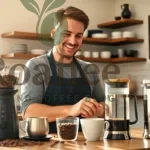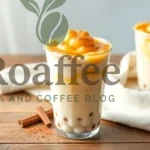There’s nothing quite like the soothing warmth of a perfectly brewed herbal tea to transform an ordinary moment into something special. Whether you’re seeking a calming chamomile blend before bedtime or an energizing peppermint tea to kickstart your morning, we’ve discovered that making exceptional herbal tea at home is easier than you might think.
We’ll guide you through the art of brewing herbal teas that rival those from your favorite tea shop. From selecting the freshest herbs to mastering the perfect steeping time, these simple techniques will elevate your tea-making game and unlock incredible flavors you never knew existed.
Ready to ditch those expensive store-bought tea bags and create your own aromatic blends? Let’s jump into the wonderful industry of homemade herbal teas that’ll have your taste buds dancing and your stress melting away with every sip.
Equipment Needed
Brewing exceptional herbal tea requires minimal equipment that most home kitchens already contain. We recommend gathering these essential tools before starting your tea-making journey.
Basic Brewing Essentials:
- Tea kettle or saucepan for heating water
- Fine-mesh strainer or tea infuser
- Teapot or heat-resistant glass container
- Measuring spoons for precise herb portions
- Timer for accurate steeping control
Optional Enhancement Tools:
- Digital kitchen scale for consistent measurements
- Thermometer for optimal water temperature
- French press for convenient brewing and straining
- Mortar and pestle for crushing dried herbs
- Glass teapot for visual brewing appreciation
Water heating forms the foundation of quality herbal tea preparation. Electric kettles provide quick heating while stovetop kettles offer temperature control flexibility. We prefer kettles with variable temperature settings since different herbs require exact water temperatures for optimal extraction.
Straining equipment determines the clarity and texture of your final brew. Fine-mesh strainers remove all plant material while tea balls and infusers contain loose herbs during steeping. Cheesecloth works excellently for delicate herbs that might slip through standard strainers.
Storage containers preserve herb freshness between brewing sessions. Airtight glass jars protect dried herbs from moisture and light exposure. Small bowls help organize multiple herbs when creating custom blends.
Measurement accuracy ensures consistent flavor profiles across multiple brewing sessions. Digital scales provide precise measurements for dried herbs while measuring spoons work well for fresh ingredients. We recommend keeping dedicated measuring tools specifically for tea preparation to avoid flavor contamination from cooking spices.
Ingredients
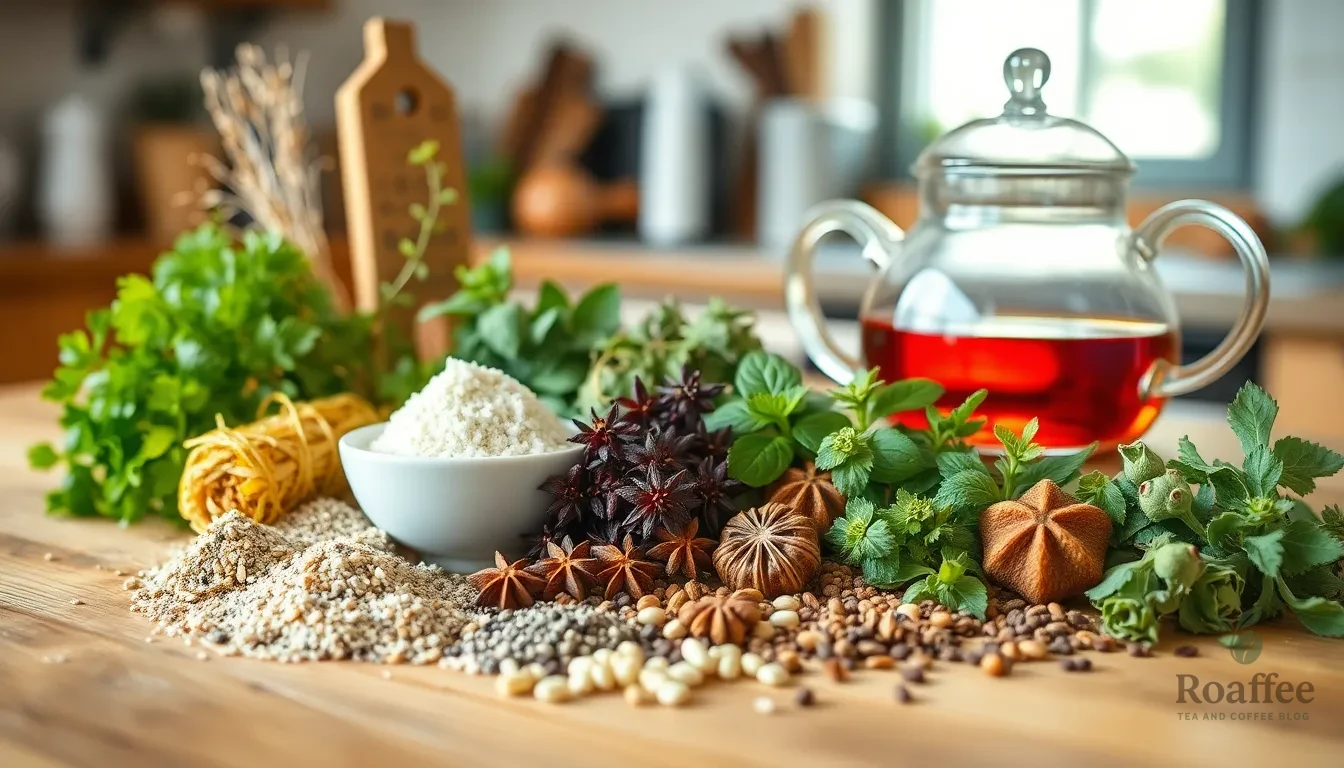
Creating exceptional herbal tea requires carefully selecting the right ingredients that will deliver the perfect balance of flavor and aroma. We’ll guide you through each component to ensure your homemade brews exceed your expectations.
Fresh Herbs
Fresh herbs provide vibrant flavors and essential vitamins that create lighter, more delicate tea profiles. We recommend using 3 tablespoons per cup of boiling water for optimal extraction. Gently muddle these herbs to release their essential oils without crushing them too hard, which can introduce unwanted bitterness.
Our favorite fresh herbs include:
- Mint leaves for cooling refreshment
- Lemongrass stalks for citrusy brightness
- Holy basil for earthy complexity
- Fresh rosemary sprigs for pine-like aromatics
- Thyme branches for subtle herbal depth
- Oregano leaves for Mediterranean warmth
Dried Herbs
Dried herbs offer concentrated flavors that create robust, full-bodied teas perfect for longer steeping times. We use 1 tablespoon per cup of boiling water as our standard measurement. Lightly crush these herbs before steeping to unlock their stored flavors and essential compounds.
Keep in mind that older dried herbs lose potency over time, so we may need to increase the quantity for desired strength. Store dried herbs in airtight containers away from light and heat to maintain their effectiveness.
Optional Add-ins
These flavor enhancers allow us to customize our herbal teas and create unique blends that suit our preferences:
Spices:
- Crushed fresh ginger for warming heat
- Cardamom pods for exotic sweetness
- Cinnamon sticks for comforting spice
Natural Sweeteners:
- Raw honey for floral notes
- Organic sugar for clean sweetness
- Maple syrup for caramel undertones
Dried Fruits & Flowers:
- Dried apple pieces for fruity sweetness
- Rose petals for delicate floral essence
- Hibiscus flowers for tart complexity
Milk Options:
- Regular dairy milk for creamy richness
- Soy milk for nutty undertones
- Almond milk for light sweetness
- Cashew milk for velvety texture
Remember to add almond or cashew milk after removing from heat to prevent curdling during the brewing process.
Directions
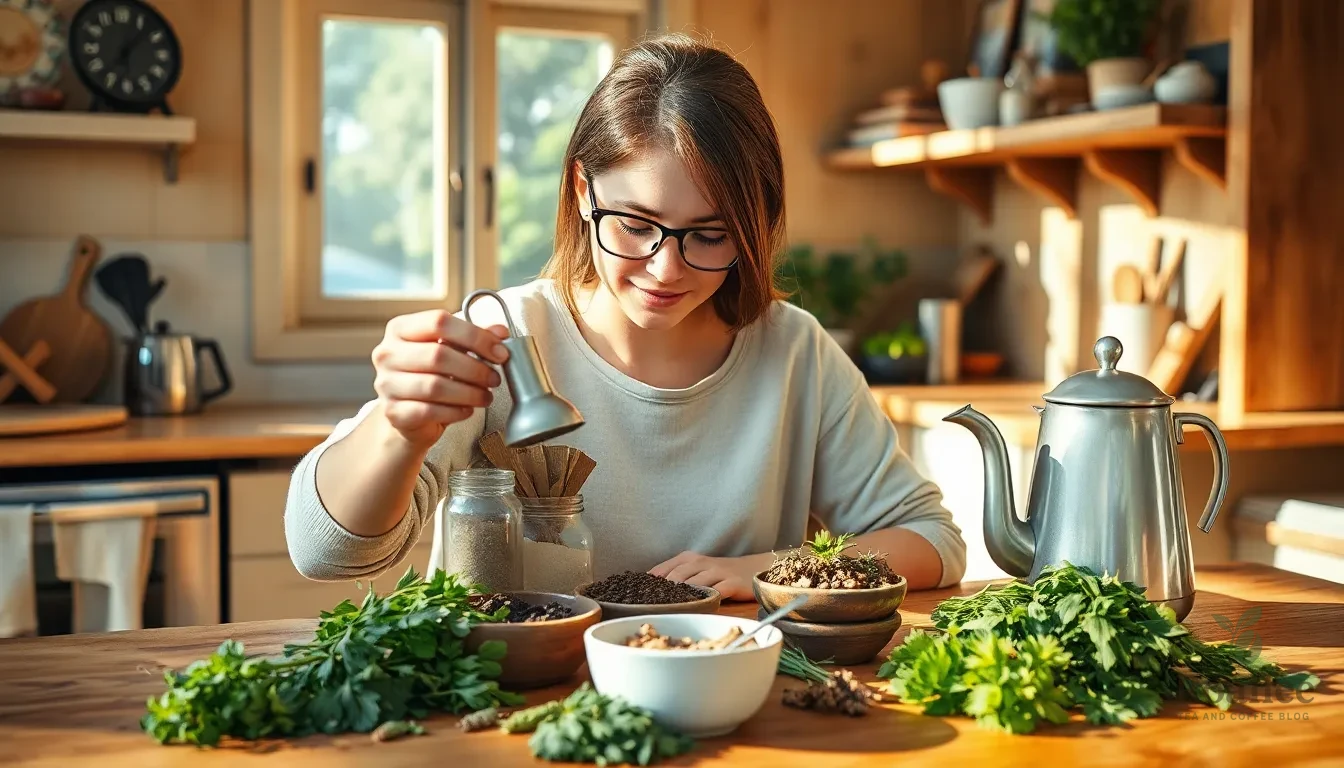
Creating the perfect herbal tea requires attention to detail and proper technique. We’ll guide you through each essential step to ensure maximum flavor extraction and aromatic intensity.
Prep the Herbs
We measure 1 teaspoon of dried herbs or 1-2 tablespoons for larger servings to achieve optimal flavor concentration. Fresh herbs require 3 tablespoons per cup while dried herbs need only 1 tablespoon per cup for the ideal strength. Loose leaves deliver superior freshness and potency compared to premade tea bags, though both options work effectively.
We place loose herbs directly into a tea strainer or reusable tea bags for easy removal later. Lightly crushing dried herbs between our fingers releases essential oils and enhances flavor extraction during brewing. This preparation step ensures even steeping and prevents bitter compounds from overwhelming the delicate herbal notes.
Heat the Water
We bring fresh filtered water to a full boil using a kettle or stovetop method. Herbal teas require boiling water at 212°F (100°C) to fully extract beneficial compounds and intense flavors from the plant materials. Quality water makes a important difference in the final taste profile of our herbal infusion.
We preheat our teapot or cup by rinsing it with hot water before adding the herbs. This technique maintains optimal brewing temperature and improves the overall extraction process. The preheating step prevents temperature shock and ensures consistent steeping throughout the brewing cycle.
Steep the Tea
We place the prepared herbs in our teapot or cup and pour the boiling water over them, ensuring complete submersion. Covering the tea vessel traps volatile oils and maintains consistent heat during the steeping process. These essential oils contain the most potent flavors and therapeutic properties of the herbs.
We steep the tea for 5-7 minutes minimum, though 8-10 minutes or longer produces more intense flavor and maximum health benefits. Herbal teas handle extended steeping times without developing bitter compounds like traditional teas. Longer steeping extracts more beneficial compounds and creates a richer, more complex flavor profile.
Strain and Serve
We remove the tea strainer or infuser to prevent over-extraction and maintain the desired flavor balance. Pouring the strained tea into serving cups leaves all herb particles behind for a clean, smooth drinking experience. We taste the finished tea and add natural sweeteners if desired to complement the herbal flavors.
We serve the tea immediately while hot to enjoy the full aromatic experience and maximum therapeutic benefits. The fresh herbal infusion delivers optimal flavor intensity and warming properties when consumed at proper serving temperature. Each cup provides the complete essence of our carefully selected herbs in their most potent form.
Popular Herbal Tea Combinations
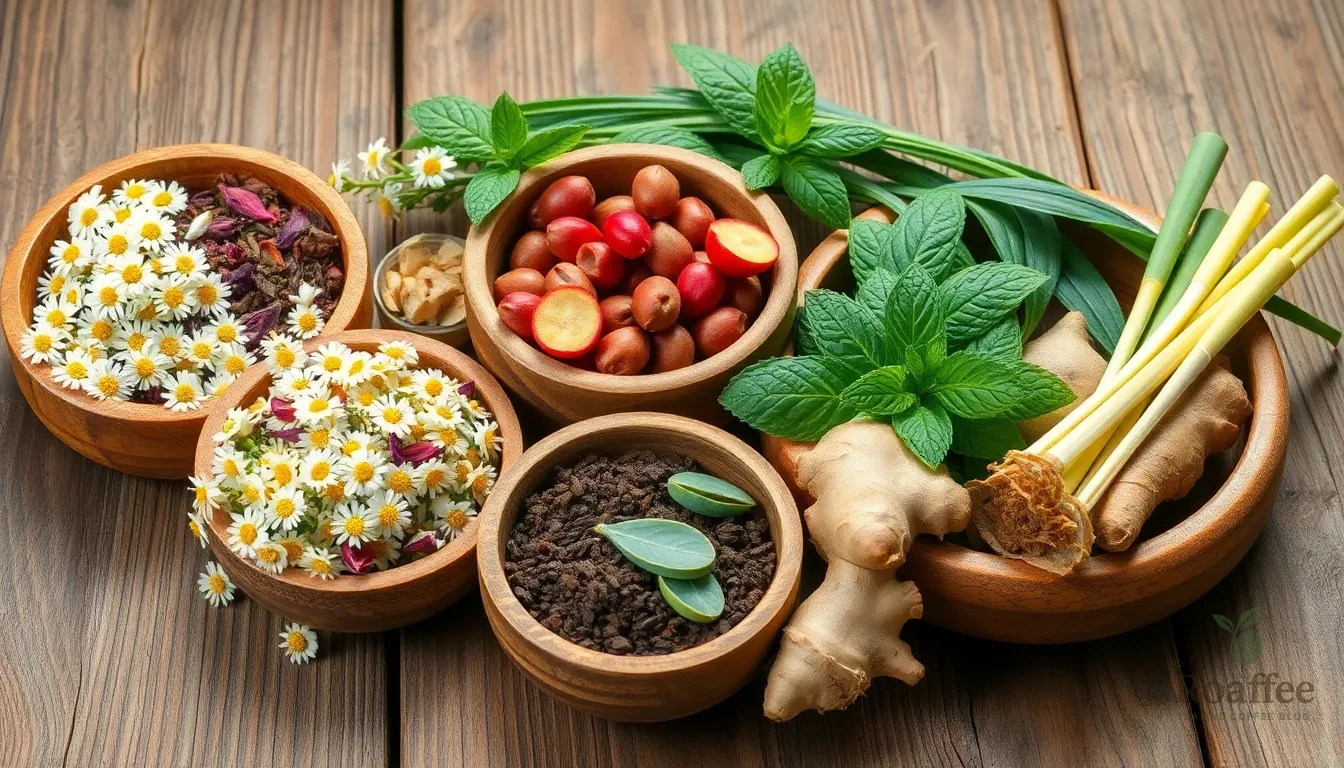
Creating the perfect herbal tea blend transforms your brewing experience from ordinary to extraordinary. We’ve curated time-tested combinations that deliver exact benefits while offering delightful flavors that will enhance your daily tea ritual.
Relaxing Blends
Chamomile forms the foundation of our most beloved calming blend. We combine 2 parts chamomile with 2 parts rosehips and 2 parts peppermint plus 1 part lemon balm for a soothing cup that promotes relaxation. This mixture steeps for 10 minutes to release its full therapeutic potential.
Our “Peace on Earth” blend offers another pathway to tranquility. We blend skullcap with passionflower and chamomile then add refreshing spearmint with a pinch of stevia for natural sweetness. The combination provides mild sedative effects that help calm both mind and body after stressful days.
| Relaxing Blend Components | Parts | Steeping Time |
|---|---|---|
| Chamomile | 2 | 10 minutes |
| Rosehips | 2 | 10 minutes |
| Peppermint | 2 | 10 minutes |
| Lemon Balm | 1 | 10 minutes |
Energizing Blends
Ginger provides the warming base for our most invigorating herbal tea combinations. We blend fresh ginger with aromatic cardamom and refreshing lemongrass to create an energizing drink that stimulates circulation and awakens the senses. Indian herbal chai showcases this powerful trio beautifully.
Fresh mint adds an invigorating element to any energizing blend. We often combine mint with ginger and lemongrass for a refreshing morning drink that provides natural energy without caffeine. The warming properties of cardamom complement these ingredients perfectly while adding aromatic depth.
Our energizing blends work best when we crush fresh ginger and cardamom pods before adding them to boiling water. This technique releases essential oils that maximize both flavor and therapeutic benefits.
Digestive Blends
Peppermint leads our digestive support combinations with its proven ability to soothe stomach discomfort. We pair peppermint with fennel seeds to create a powerful blend that relieves bloating and supports healthy digestion. Fresh ginger adds warming properties that further enhance digestive benefits.
Lemon balm rounds out our digestive blends with its gentle gut-supporting properties. We combine it with peppermint and fennel for a comprehensive digestive tea that tastes as good as it makes you feel. These herbs work individually or together depending on your exact needs.
| Digestive Support Herbs | Primary Benefit | Best Used |
|---|---|---|
| Peppermint | Soothes digestion | After meals |
| Fennel seeds | Relieves bloating | Before or after eating |
| Ginger | Aids digestion | Throughout the day |
| Lemon balm | Supports gut health | Evening hours |
Each digestive blend requires careful attention to steeping time. We recommend 5-7 minutes for optimal extraction while avoiding bitter flavors that can develop with longer steeping periods.
Storage Tips

Proper storage techniques ensure our herbal tea ingredients maintain their potency and flavor for extended periods. We maximize the shelf life of fresh herbs, dried herbs, and prepared tea by following exact preservation methods.
Storing Fresh Herbs
We achieve optimal freshness by selecting only clean and disease-free herbs for storage. Gentle washing under cool water removes any debris while preserving the delicate leaves.
After washing, we shake off excess moisture and trim the stems to prepare the herbs for storage. Place the herbs in a glass container with approximately 1 inch of water at the bottom. Cover loosely with a plastic bag to maintain air circulation while preventing dehydration.
Refrigerator storage works best for fresh herbs when we change the water daily. This method extends their usable life significantly compared to leaving them at room temperature. Fresh herbs maintain peak flavor when used immediately after harvesting or purchasing.
Storing Dried Herbs
Airtight containers protect our dried herbs from the primary enemies of flavor degradation: oxygen and moisture. Glass jars with tight-fitting lids provide excellent protection against these elements.
Vacuum-sealed bags offer another effective storage solution by completely excluding air exposure. We store these containers in cool, dark, and dry locations away from heat sources and direct sunlight.
| Storage Factor | Impact on Herb Quality |
|---|---|
| Oxygen exposure | Causes oxidation and flavor loss |
| Moisture | Leads to mold and degradation |
| Heat | Accelerates potency decline |
| Light | Breaks down beneficial compounds |
Temperature fluctuations can compromise the integrity of our dried herbs, so we maintain consistent storage conditions throughout the year.
Storing Prepared Tea
Refrigerated storage in sealed containers keeps our prepared herbal tea fresh for consumption. We consume brewed tea within 1-2 days to maintain optimal flavor and therapeutic properties.
Gentle reheating preserves the delicate herbal qualities we worked to extract during the brewing process. Avoid prolonged boiling after initial preparation, as excessive heat can diminish the beneficial compounds in our carefully crafted herbal blends.
Room temperature storage is not recommended for prepared tea, as it can develop off-flavors and potentially harmful bacteria within hours of brewing.
Serving Suggestions
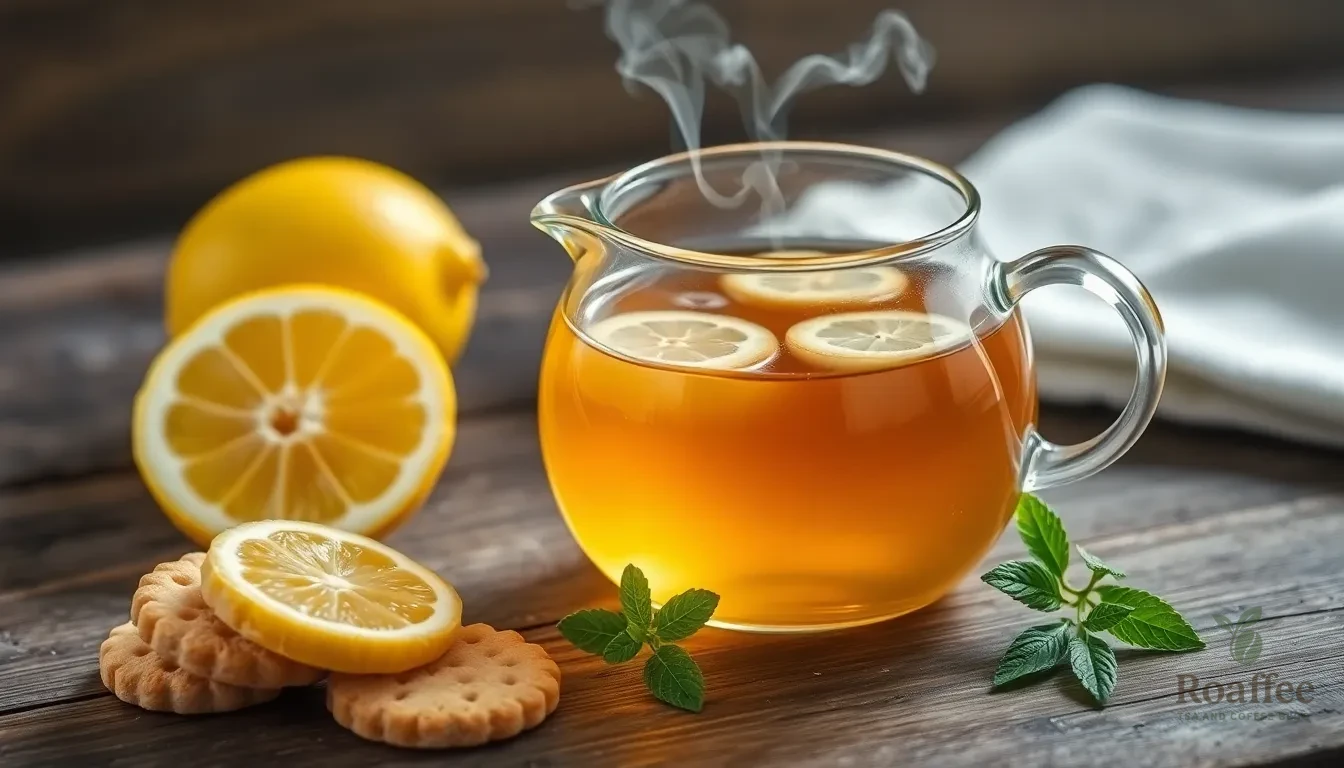
We serve herbal tea at its optimal temperature to fully appreciate its aromatic and therapeutic properties. Hot herbal tea delivers the most potent flavor profile and allows us to experience the full range of essential oils and beneficial compounds released during steeping.
Hot Serving Options
We recommend serving herbal tea immediately after straining while it maintains its ideal temperature of 150-160°F. Adding natural sweeteners like honey or maple syrup enhances the flavor without overwhelming the delicate herbal notes. Fresh lemon slices complement most herbal blends and provide additional vitamin C benefits.
For Indian-style herbal chai preparation we incorporate warm milk and preferred sweeteners after the steeping process. This creates a rich creamy texture that pairs beautifully with ginger cardamom and lemongrass combinations.
Iced Herbal Tea Preparation
We brew iced herbal tea using concentrated ratios to prevent dilution from melting ice. Starting with half the normal water amount during brewing ensures the final drink maintains its intended strength. Once strained we add cold water to reach desired volume before serving over ice.
Garnishing iced herbal tea with fresh mint leaves or cinnamon sticks creates visual appeal and adds complementary flavors. We serve iced versions within 2-3 hours of preparation for optimal taste and safety.
Custom Enhancement Ideas
| Enhancement Type | Suggested Additions | Best Paired With |
|---|---|---|
| Citrus Elements | Lemon, lime, orange zest | Mint, lemongrass blends |
| Spice Accents | Cinnamon sticks, star anise | Ginger, cardamom teas |
| Natural Sweeteners | Raw honey, agave nectar | Chamomile, elderberry blends |
| Dairy Options | Whole milk, coconut milk | Chai-style preparations |
We customize serving presentations by using clear glass teapots to showcase the beautiful golden or amber colors of properly steeped herbal teas. Serving alongside small spoons allows guests to stir in their preferred sweeteners and creates an interactive tea experience.
Pairing herbal tea with light snacks like shortbread cookies or fresh fruit enhances the overall enjoyment without competing with the tea’s natural flavors. We avoid serving heavily spiced foods that might overpower the subtle herbal notes we’ve carefully extracted during the brewing process.
Conclusion
We’ve shared everything you need to transform your daily tea ritual into something truly extraordinary. From selecting the perfect herbs to mastering steeping techniques and creating custom blends there’s no limit to what you can achieve in your own kitchen.
The beauty of homemade herbal tea lies in its simplicity and endless possibilities. With just a few basic tools and quality ingredients you’ll save money while enjoying fresher more flavorful teas than anything you’ll find in stores.
Now it’s time to put these techniques into practice. Start with one simple blend that appeals to your taste preferences and gradually experiment with different combinations. Your perfect cup of herbal tea is waiting to be discovered.
Frequently Asked Questions
What equipment do I need to brew herbal tea at home?
Essential equipment includes a tea kettle or saucepan, fine-mesh strainer or tea infuser, teapot or heat-resistant container, measuring spoons, and a timer. Optional tools like a digital kitchen scale, thermometer, French press, mortar and pestle, and glass teapot can enhance your brewing experience and help achieve more consistent results.
How much herbs should I use for brewing herbal tea?
For fresh herbs, use 3 tablespoons per cup of boiling water. For dried herbs, use 1 tablespoon per cup and lightly crush them before steeping to unlock their flavors. These measurements ensure optimal extraction and flavor balance in your homemade herbal tea.
What’s the ideal steeping time for herbal tea?
Steep herbal tea for a minimum of 5-7 minutes. Longer steeping times yield richer flavors and enhanced health benefits. Unlike traditional teas, herbal teas rarely become bitter with extended steeping, so you can adjust the time based on your desired strength preference.
How should I store fresh and dried herbs for tea?
Store fresh herbs in the refrigerator with daily water changes to maintain freshness. Keep dried herbs in airtight containers in cool, dark places to prevent degradation. Prepared tea should be stored in sealed containers in the refrigerator and consumed within 1-2 days for optimal quality.
What are some popular herbal tea blend combinations?
Popular combinations include relaxing blends like chamomile with rosehips and peppermint, energizing blends with ginger, cardamom, and lemongrass, and digestive blends featuring peppermint, fennel seeds, and ginger. Each blend offers specific health benefits while providing delicious flavor profiles.
What’s the best temperature for serving herbal tea?
Serve hot herbal tea immediately after straining at an ideal temperature of 150-160°F. This temperature range allows you to fully appreciate the aromatic and therapeutic properties. For iced tea, brew with concentrated ratios to prevent dilution when ice is added.
Can I add milk or sweeteners to herbal tea?
Yes, you can customize herbal tea with natural sweeteners like honey or maple syrup, and various milk options including dairy, almond, or oat milk. Add milk after removing the tea from heat to prevent curdling, and experiment with spices like cinnamon or citrus elements for enhanced flavor.















